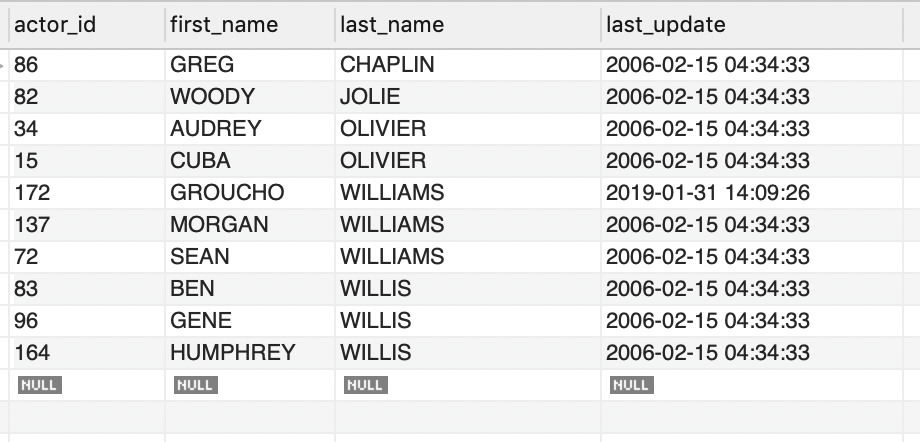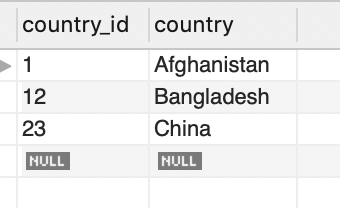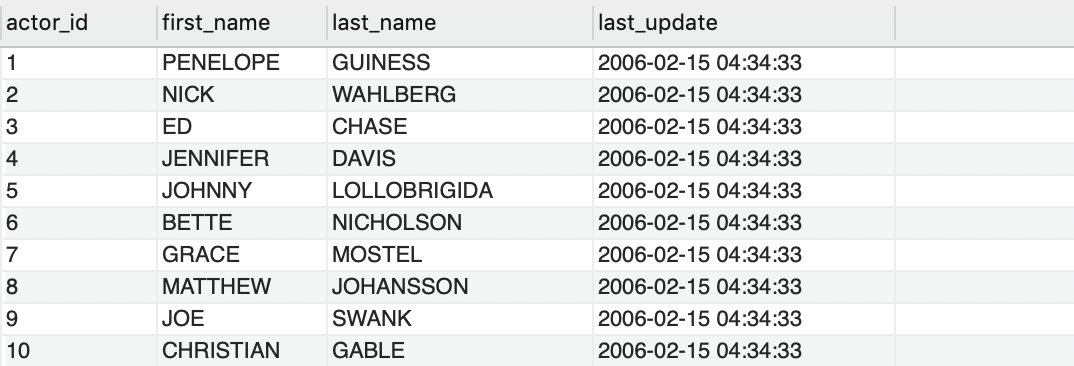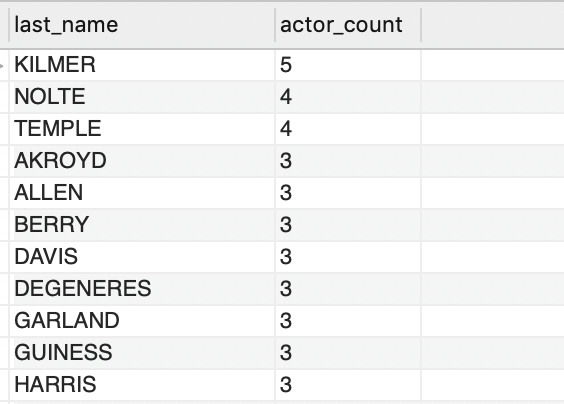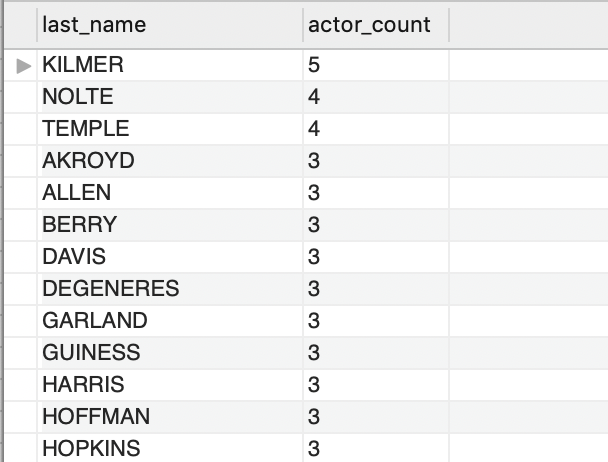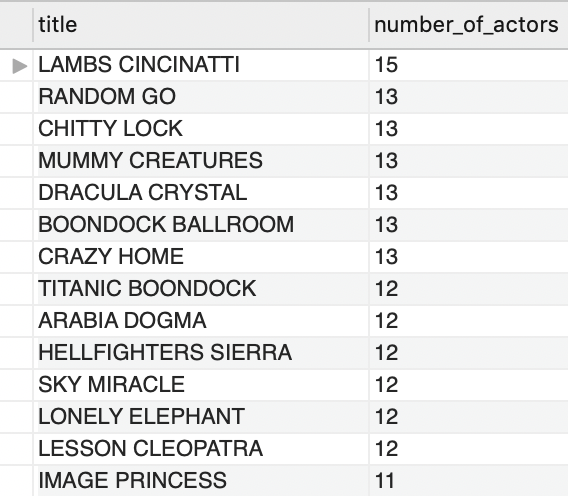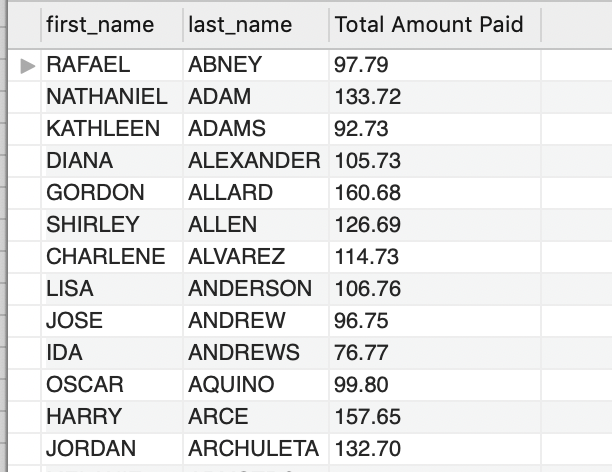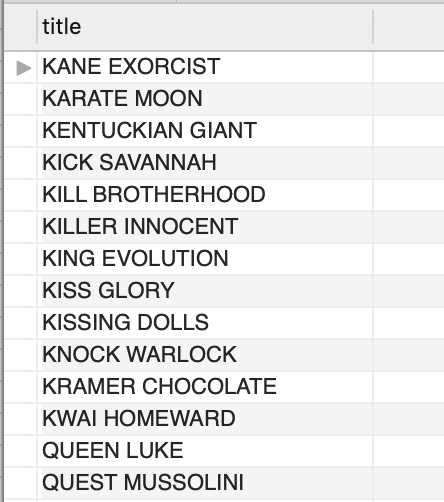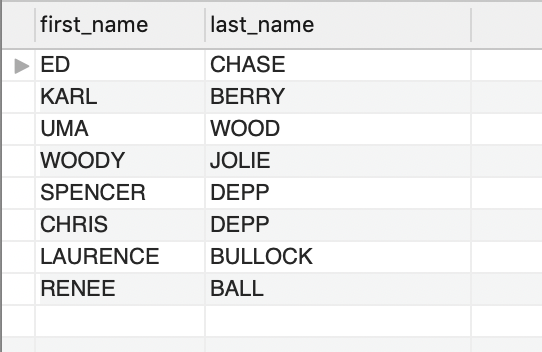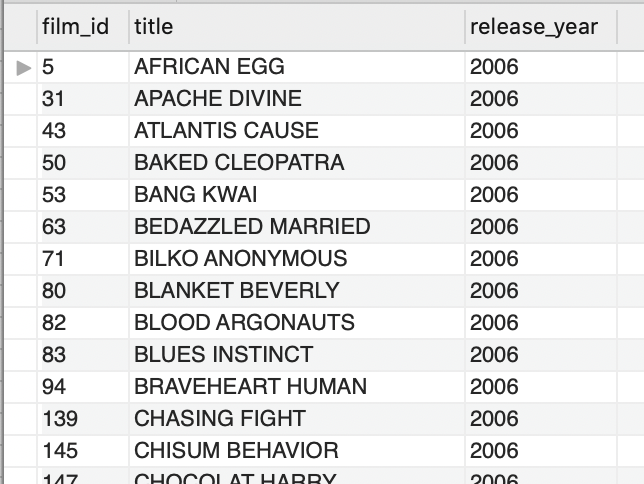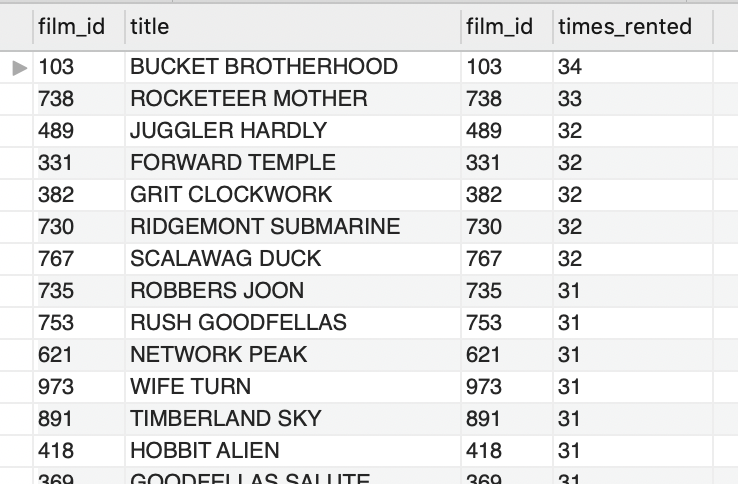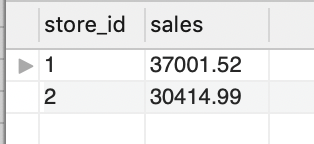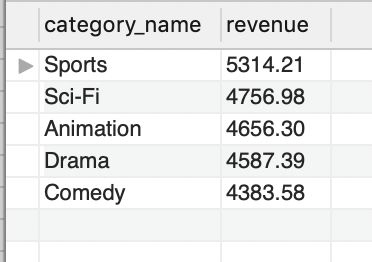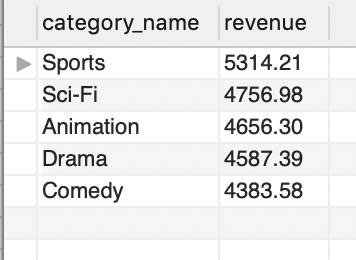Query:
select first_name, last_name
from actor;Result:
1b. Display the first and last name of each actor in a single column in upper case letters. Name the column Actor Name.
Query:
select upper(concat(first_name, ' ', last_name)) 'Actor Name'
from actor;Result:
2a. You need to find the ID number, first name, and last name of an actor, of whom you know only the first name, "Joe." What is one query would you use to obtain this information?
Query:
select actor_id, first_name, last_name
from actor
where lower(first_name) = lower("Joe");Result:
Query:
select *
from actor
where upper(last_name) like '%GEN%';Result:
2c. Find all actors whose last names contain the letters LI. This time, order the rows by last name and first name, in that order:
Query:
select *
from actor
where upper(last_name) like '%LI%'
order by last_name, first_name;Result:
2d. Using IN, display the country_id and country columns of the following countries: Afghanistan, Bangladesh, and China:
Query:
select country_id, country
from country
where country in ('Afghanistan', 'Bangladesh', 'China');Result:
3a. You want to keep a description of each actor. You don't think you will be performing queries on a description, so create a column in the table actor named description and use the data type BLOB (Make sure to research the type BLOB, as the difference between it and VARCHAR are significant).
According to Ozair Kafray @ Stackexchange.com
I would suggest using TEXT over BLOB.
Primary Difference
- TEXT and BLOB is stored off the table with the table just having a pointer to the location of the actual storage.
- VARCHAR is stored inline with the table.
Primary Guideline
1. Text format messages should almost always be stored as TEXT (they end up being arbitrarily long)
2. String attributes should be stored as VARCHAR (the destination user name, the subject, etc...).Query:
select * from actor;
ALTER TABLE actor
ADD COLUMN description BLOB;
select * from actor;Result:
3b. Very quickly you realize that entering descriptions for each actor is too much effort. Delete the description column.
Query:
select * from actor;
alter table actor
drop column description;
select * from actor;Result:
Query:
select last_name, count(*) actor_count
from actor
group by last_name
order by actor_count desc, last_name;Result:
4b. List last names of actors and the number of actors who have that last name, but only for names that are shared by at least two actors
Query:
select last_name, count(*) actor_count
from actor
group by last_name
having actor_count >1
order by actor_count desc, last_name;Result:
4c. The actor HARPO WILLIAMS was accidentally entered in the actor table as GROUCHO WILLIAMS. Write a query to fix the record.
Query:
select * from actor where first_name = 'GROUCHO' and last_name = 'WILLIAMS';
update actor set first_name = 'HARPO', last_name = 'WILLIAMS' where first_name = 'GROUCHO' and last_name = 'WILLIAMS';
select * from actor where last_name = 'WILLIAMS';Result:
4d. Perhaps we were too hasty in changing GROUCHO to HARPO. It turns out that GROUCHO was the correct name after all! In a single query, if the first name of the actor is currently HARPO, change it to GROUCHO.
Query:
update actor set first_name = 'GROUCHO', last_name = 'WILLIAMS' where first_name = 'HARPO' and last_name = 'WILLIAMS';
select * from actor where last_name = 'WILLIAMS';Result:
Query:
SHOW CREATE TABLE address;Result:
CREATE TABLE `address` (
`address_id` smallint(5) unsigned NOT NULL AUTO_INCREMENT,
`address` varchar(50) NOT NULL,
`address2` varchar(50) DEFAULT NULL,
`district` varchar(20) NOT NULL,
`city_id` smallint(5) unsigned NOT NULL,
`postal_code` varchar(10) DEFAULT NULL,
`phone` varchar(20) NOT NULL,
`location` geometry NOT NULL,
`last_update` timestamp NOT NULL DEFAULT CURRENT_TIMESTAMP ON UPDATE CURRENT_TIMESTAMP,
PRIMARY KEY (`address_id`),
KEY `idx_fk_city_id` (`city_id`),
SPATIAL KEY `idx_location` (`location`),
CONSTRAINT `fk_address_city` FOREIGN KEY (`city_id`) REFERENCES `city` (`city_id`) ON UPDATE CASCADE
) ENGINE=InnoDB AUTO_INCREMENT=606 DEFAULT CHARSET=utf86a. Use JOIN to display the first and last names, as well as the address, of each staff member. Use the tables staff and address:
Query:
select stf.first_name, stf.last_name, adr.address, adr.district, adr.postal_code, adr.city_id
from staff stf
left join address adr
on stf.address_id = adr.address_id;Result:
6b. Use JOIN to display the total amount rung up by each staff member in August of 2005. Use tables staff and payment.
Query:
select stf.first_name, stf.last_name, sum(pay.amount)
from staff stf
left join payment pay
on stf.staff_id = pay.staff_id
WHERE month(pay.payment_date) = 8
and year(pay.payment_date) = 2005
group by stf.first_name, stf.last_name;Result:
6c. List each film and the number of actors who are listed for that film. Use tables film_actor and film. Use inner join.
Query:
select flm.title, count(*) number_of_actors
from film flm
inner join film_actor fim_act
on flm.film_id = fim_act.film_id
group by flm.title
order by number_of_actors desc;Result:
Query:
select flm.title, count(*) number_in_inventory
from film flm
inner join inventory inv
on flm.film_id = inv.film_id
where lower(flm.title) = lower('Hunchback Impossible')
group by flm.title;Result:
6e. Using the tables payment and customer and the JOIN command, list the total paid by each customer. List the customers alphabetically by last name:
Query:
select cust.first_name, cust.last_name, sum(pay.amount) 'Total Amount Paid'
from payment pay
join customer cust
on pay.customer_id = cust.customer_id
group by cust.first_name, cust.last_name
order by cust.last_name;Result:
7a. The music of Queen and Kris Kristofferson have seen an unlikely resurgence. As an unintended consequence, films starting with the letters K and Q have also soared in popularity. Use subqueries to display the titles of movies starting with the letters K and Q whose language is English.
Query:
select title
from film
where (title like 'K%' or title like 'Q%')
and language_id in (
select language_id
from language
where name = 'English'
)
order by title;Result:
Query:
select first_name, last_name
from actor
where actor_id in (
select actor_id
from film_actor
where film_id in (
select film_id from film where lower(title) = lower('Alone Trip')
)
);Result:
7c. You want to run an email marketing campaign in Canada, for which you will need the names and email addresses of all Canadian customers. Use joins to retrieve this information.
Query:
-- Subquery
select first_name, last_name, email
from customer
where address_id in (
select address_id
from address
where city_id in (
select city_id
from city
where country_id in (
select country_id
from country
where country = 'Canada'
)
)
);
-- Join
select cus.first_name, cus.last_name, cus.email
from customer cus
join address adr
on cus.address_id = adr.address_id
join city cit
on adr.city_id = cit.city_id
join country cou
on cit.country_id = cou.country_id
where cou.country = 'Canada';Result:
7d. Sales have been lagging among young families, and you wish to target all family movies for a promotion. Identify all movies categorized as family films.
Query:
select film_id, title, release_year
from film
where film_id in (
select film_id
from film_category
where category_id in (
select category_id
from category
where name = 'Family'
)
);Result:
Query:
select A.film_id, A.title, B.*
from film A
join (
select inv.film_id, count(ren.rental_id) times_rented
from rental ren
join inventory inv
on ren.inventory_id = inv.inventory_id
group by inv.film_id
) B
on A.film_id = B.film_id
order by B.times_rented desc;Result:
Query:
select A.store_id, B.sales
from store A
join (
select cus.store_id, sum(pay.amount) sales
from customer cus
join payment pay
on pay.customer_id = cus.customer_id
group by cus.store_id
) B
on A.store_id = B.store_id
order by a.store_id;Result:
Query:
select A.*, B.sales
from (
select sto.store_id, cit.city, cou.country
from store sto
left join address adr
on sto.address_id = adr.address_id
join city cit
on adr.city_id = cit.city_id
join country cou
on cit.country_id = cou.country_id
) A
join (
select cus.store_id, sum(pay.amount) sales
from customer cus
join payment pay
on pay.customer_id = cus.customer_id
group by cus.store_id
) B
on A.store_id = B.store_id
order by a.store_id;Result:
7h. List the top five genres in gross revenue in descending order. (Hint: you may need to use the following tables: category, film_category, inventory, payment, and rental.)
Query:
select cat.name category_name, sum( IFNULL(pay.amount, 0) ) revenue
from category cat
left join film_category flm_cat
on cat.category_id = flm_cat.category_id
left join film fil
on flm_cat.film_id = fil.film_id
left join inventory inv
on fil.film_id = inv.film_id
left join rental ren
on inv.inventory_id = ren.inventory_id
left join payment pay
on ren.rental_id = pay.rental_id
group by cat.name
order by revenue desc
limit 5;Result:
8a. In your new role as an executive, you would like to have an easy way of viewing the Top five genres by gross revenue. Use the solution from the problem above to create a view. If you haven't solved 7h, you can substitute another query to create a view.
Query:
create view top_five_genres as
select cat.name category_name, sum( IFNULL(pay.amount, 0) ) revenue
from category cat
left join film_category flm_cat
on cat.category_id = flm_cat.category_id
left join film fil
on flm_cat.film_id = fil.film_id
left join inventory inv
on fil.film_id = inv.film_id
left join rental ren
on inv.inventory_id = ren.inventory_id
left join payment pay
on ren.rental_id = pay.rental_id
group by cat.name
order by revenue desc
limit 5;Query:
select * from top_five_genres;Result:
Query:
drop view top_five_genres;



